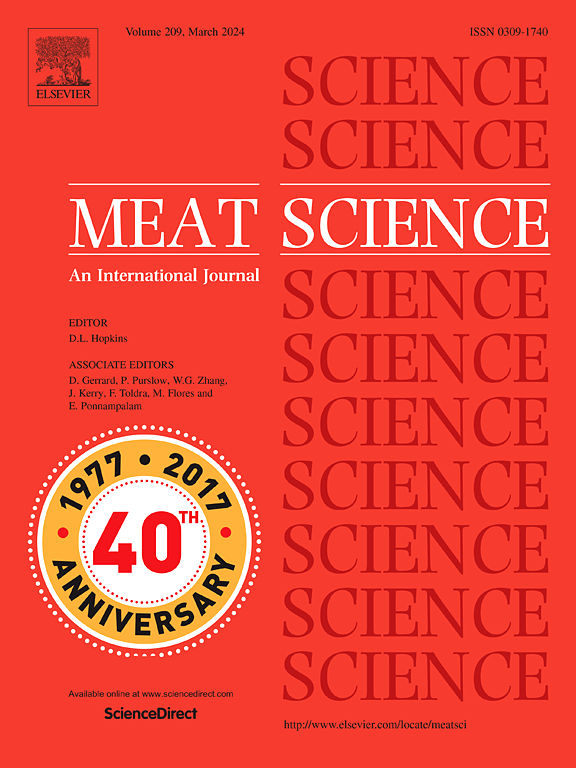水解胶原蛋白,KCl和精氨酸:一种成功的策略,以减少脂肪和钠,同时保持莫拉台拉的物理化学,感官和保质期质量
IF 7.1
1区 农林科学
Q1 Agricultural and Biological Sciences
引用次数: 0
摘要
用50%和70%的水解胶原蛋白(HC)代替动物脂肪,用KCl代替50%的NaCl,添加1%的精氨酸,重新配制Mortadellas。评估了这些变化对物理化学性质、感官属性和在4°C下超过60天的保质期的影响。结果表明,用HC代替50%和70%的脂肪,脂肪含量分别降低42.6%和55.3%,蛋白质水平分别提高37%和55%。用KCl代替50%的NaCl,钠含量降低33.2%,钾含量提高234.7%。50%的HC替代品是最合适的,因为它保留了感官属性和结构完整性,不像70%的替代品,这会对质地和味道产生负面影响。虽然用氯化钾代替氯化钠会带来苦味和金属味等感官缺陷,但添加精氨酸有效地掩盖了这些问题,使感官质量与对照组相当。通过TBARS值和感官评估来评估氧化稳定性,在整个储存过程中,所有处理都保持了类似的氧化稳定性。在重新配制的产品和对照中,嗜氧中温微生物和乳酸菌的计数进化相似,确保了微生物的稳定性。pH值在处理过程中保持一致,颜色稳定性(通过ΔE值评估)在整个储存过程中保持不变。这些结果强调了用HC, KCl和精氨酸重新配制mortadella的可行性,以生产更健康的产品,而不会影响感官质量,物理化学稳定性或保质期。本文章由计算机程序翻译,如有差异,请以英文原文为准。
Hydrolyzed collagen, KCl, and arginine: A successful strategy to reduce fat and sodium while maintaining the physicochemical, sensory, and shelf life quality of mortadella
Mortadellas were reformulated by replacing animal fat with hydrolyzed collagen (HC) at 50 % and 70 % levels, substituting 50 % NaCl with KCl, and adding 1 % arginine. The effects of these changes on physicochemical properties, sensory attributes, and shelf life over 60 days at 4 °C were evaluated. The results showed that substituting 50 % and 70 % of fat with HC reduced fat content by 42.6 % and 55.3 %, respectively, while increasing protein levels by 37 % and 55 %. Replacing 50 % of NaCl with KCl reduced sodium content by 33.2 % and increased potassium content by 234.7 %. The 50 % HC substitution was the most suitable, as it preserved sensory attributes and structural integrity, unlike the 70 % replacement, which negatively affected texture and taste. Although substituting NaCl with KCl introduced sensory defects like bitter and metallic tastes, adding arginine effectively masked these issues, resulting in sensory quality comparable to the control. Oxidative stability, evaluated through TBARS values and sensory assessments, was similarly maintained across all treatments throughout storage. Counts of aerobic mesophilic microorganisms and lactic acid bacteria evolved similarly in reformulated products and the control, ensuring microbiological stability. The pH levels remained consistent across treatments, and color stability, assessed by ΔE values, was preserved throughout storage. These results highlight the feasibility of reformulating mortadellas with HC, KCl, and arginine to produce healthier products without compromising sensory quality, physicochemical stability, or shelf life.
求助全文
通过发布文献求助,成功后即可免费获取论文全文。
去求助
来源期刊

Meat Science
工程技术-食品科技
CiteScore
12.60
自引率
9.90%
发文量
282
审稿时长
60 days
期刊介绍:
The aim of Meat Science is to serve as a suitable platform for the dissemination of interdisciplinary and international knowledge on all factors influencing the properties of meat. While the journal primarily focuses on the flesh of mammals, contributions related to poultry will be considered if they enhance the overall understanding of the relationship between muscle nature and meat quality post mortem. Additionally, papers on large birds (e.g., emus, ostriches) as well as wild-captured mammals and crocodiles will be welcomed.
 求助内容:
求助内容: 应助结果提醒方式:
应助结果提醒方式:


